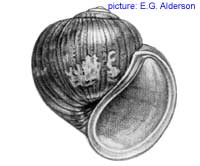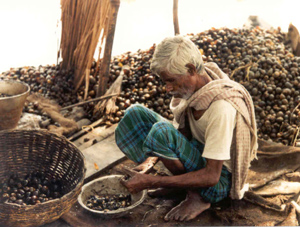|
Pila globosa (Swainson, 1822)
|
 Pila globosa (picture not licenced under creative commons) |
Shell: The shell is globose with
an oval opening. In contrast with Pila ampullacea,
Pila globosa has a large and deep umbilicus.
The colour varies from olive green to grey green with a tinge of red. A large
number of variations are known. The interior of the shell is dull reddish with
very faint spiral bands visible, white at the columella.
Operculum: The operculum is calcified at the inside (part attached to
the snail).
Body: ?
Eggs: The calcareous, white eggs of Pila globosa are deposited above
the waterline in a natural depression or snail made pit in the ground.
The size of the eggs vary from 4 to 7 mm diameter.
Hatching occurs after 2 - 3 weeks depending on the temperature.
 Pila globosa snails in *large* amounts. These snails are collected in Bangladesh with the purpose to use them as shrimp (gher) food. Picture courtesy of Care international (picture not licenced under creative commons) |
 Once collected, the Pila globosa are removed from their shell prior to feeding them to the shrimps. Picture courtesy of Care international (picture not licenced under creative commons) |
Food:
Behaviour:
Distribution: Inhabits a large area from North-Central India to Bankok.
Sinistral shell reported in
1981: 3.41 Jelatura, Sri Lanka.
Interesting link: Environmental impacts of gher farming from CARE International. Gher farmers in Bangladesh have traditionally use the meat from the freshwater Apple Snail (Pila globosa) as a feed for prawns.
|
Except where otherwise noted, this page is licensed under a Creative Commons Attribution-NonCommercial-ShareAlike 2.5 License . http://www.applesnail.net |
|